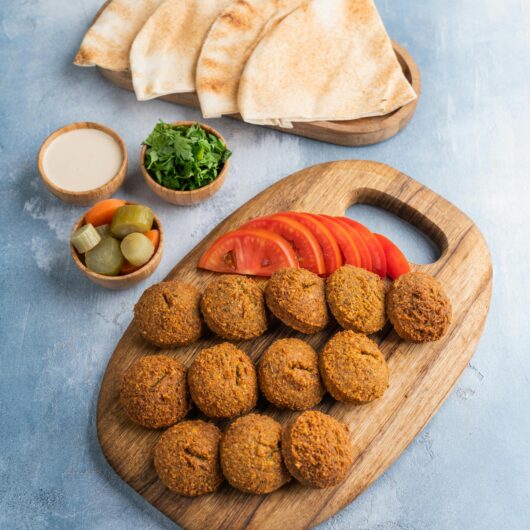
Traditional Falafel Recipe
Homemade vegan falafel is a versatile dish that can be enjoyed in numerous ways, making it an ideal addition to a plant-based diet. One of the most popular traditional accompaniments is tahini sauce, which not only adds a creamy texture but also complements the nutty flavor profile of the falafel. A simple blend of tahini, lemon juice, garlic, and water creates a delicious dip or dressing that elevates the dish significantly.
Another classic pairing is fresh salads. Serving falafel over a bed of mixed greens, cucumber, tomatoes, and red onion can create a refreshing meal that is both nutritious and satisfying. Adding a drizzle of olive oil or a vinaigrette dressing enhances the overall flavor experience. For an extra boost of protein and fiber, consider incorporating legumes or quinoa into the salad.
Pita bread is another fantastic option for serving falafel. Stuffing warm pita with falafel balls, fresh vegetables, and your choice of sauce transforms it into a satisfying wrap. This approach is not only convenient for on-the-go meals but also allows for personalized toppings, from pickled vegetables to spicy harissa. For a contemporary twist, consider integrating falafel into grain bowls. Pair them with brown rice, farro, or couscous, and layer roasted seasonal vegetables and sauces for a colorful and nourishing meal.
Falafel can also work wonderfully as a topping for grain salads, where it adds texture and flavor that complements the other components. By thinking outside traditional serving methods, you can enjoy falafel in a multitude of contexts, thus highlighting its adaptability as a healthy and vegan meal choice. Whether served in wraps, bowls, or alongside salads, homemade falafel can transform any meal into a delightful culinary experience.
Ingredients:
- 1 cup dried chickpeas (do not use canned!)
- 1 small onion, roughly chopped
- 3–4 garlic cloves, peeled
- 1 cup fresh parsley (packed)
- 1 cup fresh cilantro (packed)
- 1 tsp ground cumin
- 1 tsp ground coriander
- ½ tsp cayenne pepper (optional, for heat)
- 1½ tsp salt
- ½ tsp baking soda
- 1 tbsp lemon juice
- 2–3 tbsp flour (as needed for binding)
- Oil for frying (vegetable, canola, or sunflower)
Instructions:
- Soak the Chickpeas:
- Place the dried chickpeas in a large bowl, cover with plenty of cold water, and soak overnight (12–24 hours). They will triple in size.
- Prepare the Mixture:
- Drain and rinse the chickpeas well.
- In a food processor, combine soaked chickpeas, onion, garlic, parsley, cilantro, cumin, coriander, cayenne (if using), salt, and lemon juice.
- Pulse until the mixture resembles coarse sand or a fine crumb. Do not overblend—it should not be a paste.
- Add baking soda and 2 tablespoons of flour. Pulse briefly to combine.
- Test if the mixture holds together when squeezed; add more flour if too crumbly.
- Chill the Mixture:
- Transfer the mixture to a bowl, cover, and refrigerate for at least 1 hour (up to overnight). This helps it firm up and improves flavor.
- Shape the Falafel:
- Scoop and shape into small balls or patties (about 1½ inches wide). A falafel scoop or cookie scoop works great.
- Fry the Falafel:
- Heat 2 inches of oil in a heavy pot to 350°F (175°C).
- Fry falafel in batches for 3–4 minutes, until deep golden brown and crisp.
- Drain on paper towels.
🥙 Serving Suggestions:
- Pita pockets with lettuce, tomato, cucumber, pickles, and tahini or hummus.
- Falafel bowls with rice, veggies, and garlic sauce.
- Dipping with tzatziki or yogurt sauce.
✅ Tips:
- Don’t use canned chickpeas—they’ll make the mixture too soft and soggy.
- You can bake or air-fry falafel, but frying gives the best texture.
- Store leftovers in the fridge for 4 days or freeze for up to 3 months.